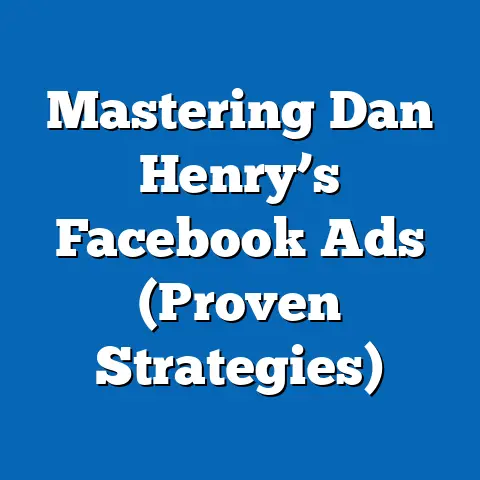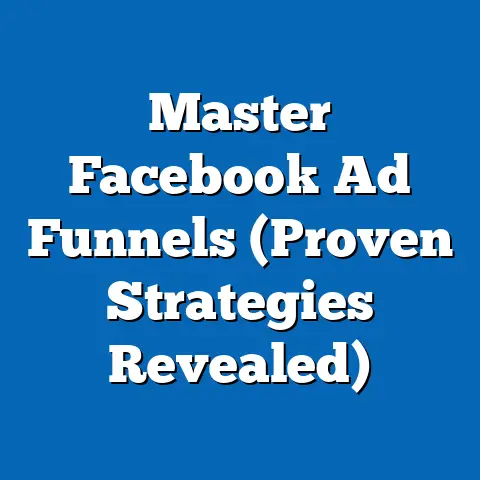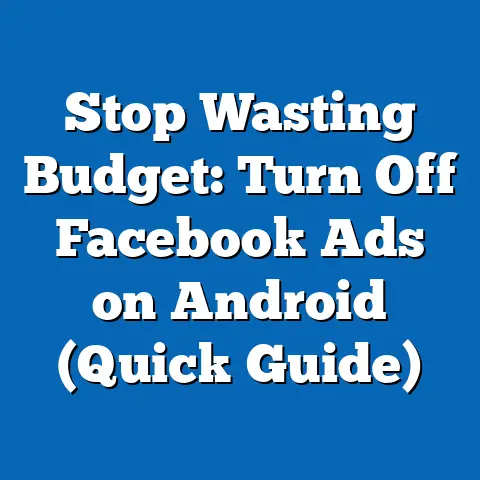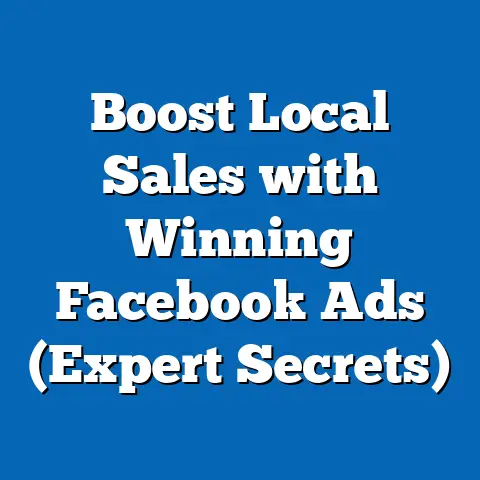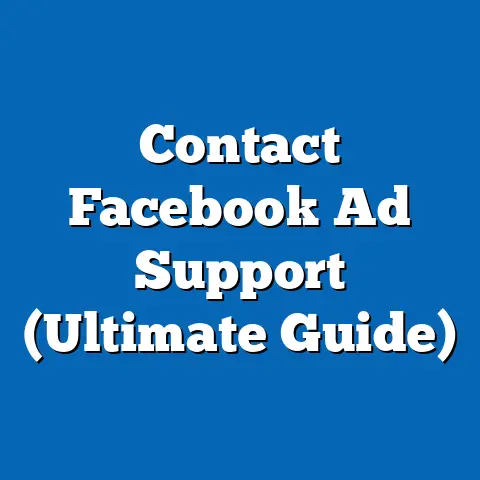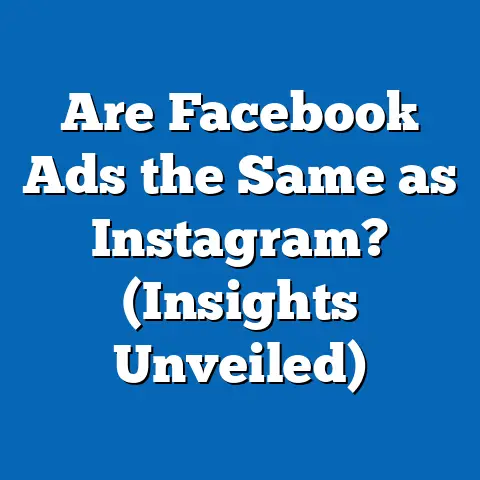Optimize Facebook Ads Text for Every User (Proven Strategies)
Crafting Facebook ads that truly resonate with your target audience is an art and a science. I’ve spent years in the trenches of digital marketing, and one thing has become abundantly clear: generic ads simply don’t cut it anymore. In today’s saturated online landscape, capturing attention and driving engagement requires a laser-focused approach that speaks directly to the individual. That’s why I’m excited to share proven strategies for optimizing your Facebook ad text for every user, ensuring maximum impact and ROI.
Understanding Your Audience
One of the biggest mistakes I see marketers make is treating their entire audience as a monolithic entity. This is a recipe for bland, ineffective ads that fail to connect with anyone on a personal level. Audience segmentation is the cornerstone of successful Facebook advertising. By dividing your audience into smaller, more homogeneous groups based on demographics, interests, behaviors, and even past purchase history, you can craft ad text that speaks directly to their specific needs and desires.
Think of it this way: you wouldn’t use the same language to sell a luxury sports car to a college student as you would to a retired executive. The same principle applies to Facebook ads. Understanding your audience’s nuances is critical.
Gathering Audience Insights
So, how do you uncover these crucial audience insights? Fortunately, Facebook provides a wealth of tools and data to help you delve deep into your target market.
- Facebook Audience Insights: This powerful tool allows you to explore the demographics, interests, behaviors, and lifestyles of people connected to your Facebook page or custom audiences. I’ve used it countless times to identify hidden interests and niche segments within my target market.
- Customer Surveys: Don’t underestimate the power of directly asking your customers what they want. Surveys can provide invaluable qualitative data about their motivations, pain points, and language preferences. I often use tools like SurveyMonkey or Google Forms to gather this information.
- Website Analytics: Your website analytics can reveal a treasure trove of information about your audience’s behavior on your site, including the pages they visit, the products they view, and the keywords they use to find you. This data can help you understand their interests and needs.
- CRM Data: If you have a CRM system, leverage the data you’ve collected on your existing customers, including their purchase history, demographics, and communication preferences.
Creating Buyer Personas
Once you’ve gathered your audience insights, it’s time to create buyer personas. These are fictional representations of your ideal customers, based on research and data. Each persona should have a name, a background, a set of goals and challenges, and a unique set of communication preferences.
For example, let’s say you’re selling online courses. You might create a persona named “Sarah,” a 30-year-old marketing professional who’s looking to upskill and advance her career. You might also create a persona named “David,” a 50-year-old entrepreneur who’s looking to learn new skills to grow his business.
By creating these personas, you can start to think about how to tailor your ad text to resonate with each individual’s unique needs and motivations.
Key Takeaway: Understanding your audience is paramount. Utilize Facebook Audience Insights, customer surveys, website analytics, and CRM data to gather insights and create detailed buyer personas.
Crafting Compelling Headlines
In the fast-paced world of social media, your headline is your first (and often only) chance to grab attention. It’s the hook that lures users in and compels them to learn more about your offer. A weak or irrelevant headline will be quickly scrolled past, while a compelling headline can spark curiosity, pique interest, and drive clicks.
I’ve seen countless campaigns succeed or fail based solely on the strength of the headline. It’s that critical.
Strategies for Writing Catchy Headlines
- Keep it Concise: Aim for headlines that are short, punchy, and easy to understand. Facebook recommends keeping headlines under 25 characters to ensure they don’t get truncated on mobile devices.
- Highlight the Benefit: Focus on the key benefit that your product or service offers to the user. What problem does it solve? What desire does it fulfill?
- Use Strong Action Verbs: Start your headline with a strong action verb that encourages the user to take action. Examples include “Shop Now,” “Learn More,” “Get Started,” and “Download Now.”
- Ask a Question: Questions can be a great way to pique curiosity and engage the user. For example, “Struggling to Lose Weight?” or “Need a New Job?”
- Use Numbers and Lists: Numbers and lists tend to stand out and are easy to scan. For example, “5 Ways to Boost Your Productivity” or “3 Secrets to a Perfect Tan.”
- Create a Sense of Urgency: Urgency can motivate users to take action immediately. For example, “Limited Time Offer” or “Sale Ends Tonight.”
- Personalize the Headline: Use personalized language that speaks directly to the user. For example, “Are You a Busy Mom?” or “Attention Small Business Owners.”
Examples of Effective Headlines
Here are a few examples of effective headlines that resonate with different audience segments:
- For Fitness Enthusiasts: “Crush Your Fitness Goals with Our New Protein Powder”
- For Budget-Conscious Shoppers: “Save Up to 50% on Your Favorite Brands”
- For Busy Professionals: “Boost Your Productivity with Our Time Management Course”
- For Parents: “Keep Your Kids Entertained with Our Educational Games”
Psychological Triggers
To make your headlines even more compelling, consider incorporating psychological triggers that appeal to human emotions and motivations.
- Curiosity: Create a sense of mystery or intrigue that makes the user want to learn more. For example, “The Shocking Truth About Weight Loss” or “The One Thing You’re Missing in Your Marketing Strategy.”
- Urgency: As mentioned earlier, urgency can motivate users to take action immediately.
- Fear of Missing Out (FOMO): Tap into the user’s fear of missing out on a valuable opportunity. For example, “Don’t Miss Out on Our Exclusive Sale” or “Join the Thousands Who Are Already Benefiting from Our Program.”
- Social Proof: Highlight the popularity of your product or service. For example, “Join Over 10,000 Satisfied Customers” or “The #1 Rated App for Productivity.”
Key Takeaway: Craft compelling headlines that are concise, benefit-driven, and use strong action verbs. Incorporate psychological triggers like curiosity, urgency, and FOMO to maximize their impact.
Utilizing Emotional Language
Humans are emotional beings, and our emotions play a significant role in our decision-making process. By tapping into the user’s emotions, you can create a stronger connection and drive action. Emotional language can evoke feelings of happiness, nostalgia, excitement, fear, or even anger, depending on your product or service and your target audience.
I’ve personally witnessed the power of emotional language in advertising. Ads that connect with users on an emotional level tend to perform significantly better than those that rely solely on logic and reason.
Examples of Emotional Language
Here are some examples of emotional language that can be used in ad text, categorized by the emotional response they aim to elicit:
- Happiness: “Experience the Joy of Traveling with Our Exclusive Vacation Packages”
- Nostalgia: “Relive Your Childhood Memories with Our Classic Board Games”
- Excitement: “Get Ready for an Adventure of a Lifetime with Our Thrilling Tours”
- Urgency: “Don’t Miss Out on Our Limited-Time Offer! Shop Now and Save!”
- Fear: “Protect Your Family with Our State-of-the-Art Home Security System”
- Trust: “Join Thousands of Satisfied Customers Who Trust Our Brand”
- Empathy: “We Understand Your Struggles. Let Us Help You Find a Solution.”
Case Studies of Successful Campaigns
- Dove’s “Real Beauty” Campaign: This campaign challenged traditional beauty standards and celebrated the beauty of all women. It resonated deeply with women around the world and generated a significant amount of positive buzz for the brand.
- Always’ “Like a Girl” Campaign: This campaign aimed to redefine the phrase “like a girl” and empower young girls. It sparked a global conversation about gender stereotypes and inspired millions of people.
- Coca-Cola’s “Share a Coke” Campaign: This campaign personalized Coca-Cola bottles with people’s names and encouraged them to share a Coke with someone they cared about. It created a sense of connection and community and drove sales for the brand.
Key Takeaway: Leverage emotional language to create a stronger connection with your audience. Use words and phrases that evoke feelings of happiness, nostalgia, excitement, fear, trust, or empathy.
Incorporating Clear Calls-to-Action
Your call-to-action (CTA) is the final piece of the puzzle. It’s the instruction that tells the user what you want them to do next. A strong CTA is clear, concise, and compelling, and it motivates the user to take action.
I’ve seen many ads with great headlines and compelling body text fail to convert simply because they lacked a clear and effective CTA. Don’t let that happen to you.
Tailoring CTAs to the Buyer’s Journey
The type of CTA you use should depend on the user’s stage in the buyer’s journey:
- Awareness Stage: At this stage, the user is just becoming aware of your brand or product. Your CTA should focus on generating awareness and interest. Examples include “Learn More,” “Discover Now,” and “See How It Works.”
- Consideration Stage: At this stage, the user is considering whether or not to purchase your product. Your CTA should focus on providing more information and building trust. Examples include “Get a Free Quote,” “Download Our Guide,” and “Watch a Demo.”
- Decision Stage: At this stage, the user is ready to make a purchase. Your CTA should focus on driving conversions. Examples include “Shop Now,” “Buy Now,” and “Get Started Today.”
Examples of Strong CTAs
- Shop Now: This is a classic CTA that works well for e-commerce businesses.
- Learn More: This CTA is great for generating awareness and interest.
- Get Started Today: This CTA creates a sense of urgency and encourages immediate action.
- Download Our Free Guide: This CTA provides value to the user and builds trust.
- Request a Demo: This CTA allows users to try out your product before they buy.
Key Takeaway: Incorporate clear and compelling CTAs that guide users towards the next step. Tailor your CTAs to the user’s stage in the buyer’s journey.
Testing and Iterating Your Ad Text
The world of Facebook advertising is constantly evolving, and what works today may not work tomorrow. That’s why it’s essential to continuously test and iterate your ad text to optimize your campaigns for maximum performance.
A/B testing, also known as split testing, is a powerful technique that allows you to compare different versions of your ad text to see which one performs better.
Setting Up A/B Tests
- Headline Variations: Test different headlines to see which ones generate the most clicks and engagement.
- Body Text Variations: Test different body text to see which ones resonate most with your audience.
- CTA Variations: Test different CTAs to see which ones drive the most conversions.
- Image/Video Variations: While this article focuses on text, it’s crucial to test different visuals as well, as they work in tandem with your copy.
Analyzing Performance Metrics
Once you’ve set up your A/B tests, it’s important to track and analyze the performance metrics to see which variations are performing best.
- Click-Through Rate (CTR): This metric measures the percentage of people who click on your ad after seeing it. A higher CTR indicates that your ad text is more compelling and relevant to your audience.
- Conversion Rate: This metric measures the percentage of people who take the desired action after clicking on your ad. A higher conversion rate indicates that your ad text is effectively driving conversions.
- Cost Per Click (CPC): This metric measures the cost you pay each time someone clicks on your ad. A lower CPC indicates that your ad text is more efficient and cost-effective.
- Return on Ad Spend (ROAS): This metric measures the revenue you generate for every dollar you spend on advertising. A higher ROAS indicates that your ad text is effectively driving sales and revenue.
Key Takeaway: Continuously test and iterate your ad text to optimize your campaigns for maximum performance. Use A/B testing to compare different variations and track performance metrics like CTR, conversion rate, CPC, and ROAS.
Conclusion
Optimizing your Facebook ad text for every user is a complex but rewarding process. By understanding your audience, crafting compelling headlines, utilizing emotional language, incorporating clear CTAs, and continuously testing and iterating your ad text, you can create impactful ads that resonate with your target market and drive better results.
Remember, customization and understanding your audience are paramount. Take the time to research your audience, create buyer personas, and tailor your ad text to speak directly to their specific needs and motivations.
I encourage you to implement these proven strategies in your own Facebook advertising efforts. The results may surprise you. You’ll not only see an increase in engagement and conversions, but you’ll also build stronger relationships with your customers and create a more loyal following for your brand. Now, go out there and create some amazing Facebook ads!

